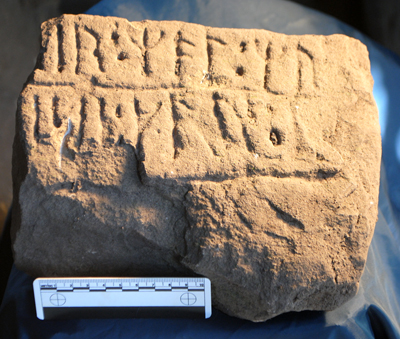Rare Runic Stone Discovery
A newly uncovered runic stone-carving was brought to light by Jane Harrison (Senior Associate Tutor working in our Archaeology programmes) working as part of a project team for the intriguing 'Languages, Myths and Finds' programme.
'Languages, Myths and Finds: Translating Norse and Viking Cultures for the Twenty-first Century' is a Collaborative Skills Development Programme that brings together graduate students and full-time researchers from across the UK and Ireland to explore the translation of Norse and Viking cultures into the modern day. The project is funded by the Arts & Humanities Research Council, and is based in five communities with Norse heritage: the Isle of Lewis, Cleveland, the Isle of Man, Dublin and Munster.
 The fragment of inscribed runestone was found in the Tees Valley at Sockburn, in the grounds of a ruined church, having been used as building stone. The inscription on it reads: Line A ... (ept)ir molmu; Line B... (re)isti krus ...
The fragment of inscribed runestone was found in the Tees Valley at Sockburn, in the grounds of a ruined church, having been used as building stone. The inscription on it reads: Line A ... (ept)ir molmu; Line B... (re)isti krus ...
Jane said, 'We compared this inscription with a formula used in many Scandinavian runes from the Isle of Man: 'X raised this cross in memory of Y'. The inscription on our stone therefore translates as (line B, then line A) '...raised cross... in memory of Máel-Muire/Máel-Maire'. Sadly, the name of the patron is lost.'
Máel-Muire or Máel-Maire is a personal name from the Goidelic - which is an Insular Celtic language from the dialect continuum stretching from Ireland through the Isle of Man to Scotland. The name is linked to the place-name Melmerby (found in Cumbria and in North Yorkshire) and also seen in a runic inscription from the Isle of Man.
'The runestone is relatively small, measuring approximately 22 cm long, 16 cm wide and 9cm deep,' said Jane. 'But it's a very exciting find, despite its small size: Scandinavian runic inscriptions in England are rare - there are fewer than 20 known.'
'The character of the runestone suggests links with the west from the north-east. The Tees Valley has been relatively neglected in studies of the period but that's likely to change. For "Vikingologists", this runestone is a great find and one that makes a fascinating contribution to understanding the Viking settlement of the North-East.'
Also remarkable is the fact that the stone was found in an area with a high concentration of Norse place names, but little in the way of archaeological and historical evidence - apart from unique hogback sculptures (large stone-carved Anglo-Scandinavian sculptures from 10th-12th century England and Scotland usually found in churchyards).
The Languages, Myths and Finds programme draws on the research ideas behind the Vikings Exhibition at the British Museum to generate new research and an understanding of the Viking Age in areas of the country where that period is important but rarely discussed. Jane worked with project leads Professor Heather O'Donoghue (University of Oxford), Dr Pragya Vohra (Aberystwyth University) and PhD students Ellie Rye, Jo Shortt Butler and Nik Gunn (from Nottingham, Cambridge and York Universities).
In addition to the runic discovery, the team produced a research booklet, spoke at a conference and performed public engagement work with local societies.
For full information on the Languages, Myths and Finds project, please see the programme website, at languagesmythsfinds.ac.uk On the website you can download and enjoy the booklets produced by each of the project teams, including Jane's team's work in Cleveland, which can be found at: languagesmythsfinds.ac.uk/north-east-england/
For information about the Department's courses in Archaeology, please see a listing of current courses at:
Published 21 July 2014
